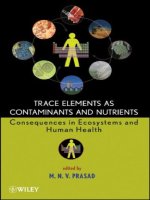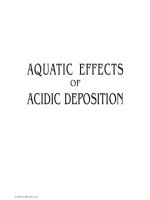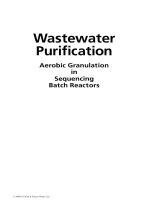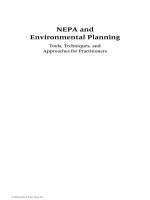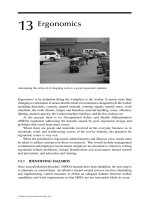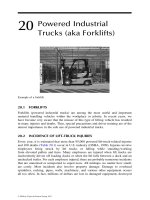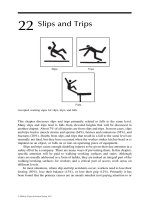Ecosystems and Human Health - Chapter 1 pptx
Bạn đang xem bản rút gọn của tài liệu. Xem và tải ngay bản đầy đủ của tài liệu tại đây (443.29 KB, 59 trang )
LEWIS PUBLISHERS
Boca Raton London New York Washington, D.C.
SECOND EDITION
Toxicology and Environmental Hazards
RICHARD B. PHILP
HUMAN
HEALTH
Ecosystems
and
©2001 CRC Press LLC
This book contains information obtained from authentic and highly regarded sources. Reprinted material
is quoted with permission, and sources are indicated. A wide variety of references are listed. Reasonable
efforts have been made to publish reliable data and information, but the author and the publisher cannot
assume responsibility for the validity of all materials or for the consequences of their use.
Neither this book nor any part may be reproduced or transmitted in any form or by any means, electronic
or mechanical, including photocopying, microfilming, and recording, or by any information storage or
retrieval system, without prior permission in writing from the publisher.
The consent of CRC Press LLC does not extend to copying for general distribution, for promotion, for
creating new works, or for resale. Specific permission must be obtained in writing from CRC Press LLC
for such copying.
Direct all inquiries to CRC Press LLC, 2000 N.W. Corporate Blvd., Boca Raton, Florida 33431.
Trademark Notice:
Product or corporate names may be trademarks or registered trademarks, and are
used only for identification and explanation, without intent to infringe.
Visit the CRC Press Web site at www.crcpress.com
© 2001 by CRC Press LLC
No claim to original U.S. Government works
International Standard Book Number 1-56670-568-1
Library of Congress Card Number 2001001149
Printed in the United States of America 1 2 3 4 5 6 7 8 9 0
Printed on acid-free paper
Library of Congress Cataloging-in-Publication Data
Philp, Richard B.
Ecosystems and human health : toxicology and environmental
hazards / Richard B. Philp – 2nd ed.
p. cm.
Includes bibliographical references and index.
ISBN 1-56670-568-1
1. Environmental toxicology. 2. Environmental health. I.
Title.
RA1226 .P48 2001
615.9'02 dc21 2001001149
CIP
©2001 CRC Press LLC
Dedication
Elizabeth, Brendan, Douglas, Danielle, William, Nathan,
Danny, Anders, Margaret, Matthew, Jemma, Lauren,
and kids everywhere. Perhaps this book will help them to look
after this place better than we did. Also for my wife Joan,
who is my calm harbor in a stormy world.
©2001 CRC Press LLC
Foreword
There is a commonly held myth in our society that anything that is “natural”
is good, wholesome, and healthful, whereas anything that is “synthetic” is
bad, toxic, and harmful. The mere mention of the word
chemical
is enough
to strike terror into the heart of any food faddist. This attitude is, at best,
naïve and, at worst, dangerous. Toxic substances abound in nature, ranging
from inorganic heavy metals such as arsenic and mercury, through organic
substances such as hydrocyanic acid, to complex enzymes and other proteins
of the neurotoxins and coagulant-anticoagulants present in venoms and
toxins. One of the more serious environmental hazards may be natural radon
gas, and cancer from solar radiation is a real concern.
Increasingly, it is becoming necessary for students of environmental sci-
ences to know something of toxicology and for students of toxicology to know
something of the environment. This text is designed to bridge these fields by
acquainting the student with the major environmental hazards — both man-
made and natural — and with the risks to human health that they pose. It is
designed such that topics are generally introduced in the early chapters and
covered in greater detail in subsequent ones. This is neither an environmen-
talist's handbook nor does it deal exclusively with toxicology; rather, it
attempts to strike a balance between the extremes of opinion and to indicate
where information is inconclusive. Examples of major accidental exposures
of humans to chemical toxicants are used liberally and case studies taken
from reported incidents are provided. Historical background of the develop-
ment of a class of chemicals or a particular environmental problem is often
provided in the belief that an educated student should know more than
merely the technical aspects of the field. It is hoped that this text will assist
students in acquiring the information and judgmental skills necessary to
differentiate between real and perceived risks, as well as acquaint them with
the toxicology of important chemicals in the environment. Because most
people spend 8 hours daily, 5 days weekly in the workplace, it constitutes an
important component of our environment and it will be considered as such.
Richard B. Philp, D.V.M., Ph.D.
©2001 CRC Press LLC
About the Author
Richard B. Philp, D.V.M., Ph.D.,
is an emeritus professor and former Chair
of the Department of Pharmacology and Toxicology at the University of
Western Ontario. After graduating from the Ontario Veterinary College, he
practiced veterinary medicine in Illinois and in Ontario and also served as
a public health officer in a small Ontario town. He obtained his Ph.D. in
pharmacology from the University of Western Ontario and did postdoctoral
studies at the Royal College of Surgeons of England in London. He has
served on advisory committees to Canadian federal and provincial govern-
ments regarding the use of antibiotics in agriculture. He was Honorary
Visiting Professor in the School of Pathology, University of New South Wales,
and has authored or co-authored over 90 scientific papers, two books, and
several book chapters. His current research involves the study of pollution
along the Florida Gulf Coast and its effects on a species of marine sponge.
©2001 CRC Press LLC
Contents
Chapter 1 Principles of pharmacology and toxicology
Introduction
Pharmacokinetics
Absorption
Distribution
Biotransformation
Elimination
Pharmacodynamics
Ligand binding and receptors
Biological variation and data manipulation
Dose response
Probit analysis
Cumulative effects
Factors influencing responses to xenobiotics
Age
Body composition
Sex
Genetic factors
Presence of pathology
Xenobiotic interactions
Some toxicological considerations
Acute vs. chronic toxicity
Acute toxicity
Peripheral neurotoxins
Central neurotoxins
Inhibitors of oxidative phosphorylation
Uncoupling agents
Inhibitors of intermediary metabolism
Chronic toxicity
Mutagenesis and carcinogenesis
Sites of intracellular damage
DNA repair
Genetic predisposition to cancer
Epigenetic mechanisms of carcinogenesis
©2001 CRC Press LLC
The role of cell repair and regeneration in toxic reactions
Response of tissues to chemical insult
Fetal toxicology
Teratogenesis
Transplacental carcinogenesis
Further reading
Review questions
Answers
Chapter 2 Risk analysis and public perceptions of risk
Introduction
Assessment of toxicity vs. risk
Predicting risk: workplace vs. the environment
Acute exposures
Chronic exposures
Very low-level, long-term exposures
Carcinogenesis
Risk assessment and carcinogenesis
Sources of error in predicting cancer risks
Portal-of-entry effects
Age effects
Exposure to co-carcinogens and promoters
Species differences
Extrapolation of animal data to humans
Hormesis
Natural vs. anthropogenic carcinogens
Reliability of tests of carcinogenesis
Environmental monitoring
Setting safe limits in the workplace
Environmental risks: problems with assessment
and public perceptions
The psychological impact of potential environmental risks
Voluntary risk acceptance vs. imposed risks
Costs of risk avoidance
Some examples of major industrial accidents and environmental
chemical exposures with human health implications
Radiation
Formaldehyde
Dioxin (TCDD)
Some legal aspects of risk
De minimis concept
Delaney Amendment
Statistical problems with risk assessment
Risk management
©2001 CRC Press LLC
The precautionary principle
Further reading
Review questions
Answers
Case study 1
Case study 2
Chapter 3 Water and soil pollution
Introduction
Factors affecting toxicants in water
Exchange of toxicants in an ecosystem
Factors (modifiers) affecting uptake of toxicants from
the environment
Abiotic modifiers
Biotic modifiers
Some important definitions
Toxicity testing in marine and aquatic species
Water quality
Sources of pollution
Some major water pollutants
Chemical classification of pesticides
Health hazards of pesticides and related chemicals
Chlorinated hydrocarbons
Chlorphenoxy acid herbicides
Organophosphates (organophosphorus insecticides)
Carbamates
Acidity and toxic metals
Chemical hazards from waste disposal
The Love Canal story
Problems with Love Canal studies
Toxicants in the Great Lakes: implications for human health
and wildlife
Evidence of adverse effects on human health
Evidence of adverse effects on wildlife
Global warming and water levels in the Great Lakes
The marine environment
Aquatic toxicology
Biological hazards in drinking water
Anatomy of a small town disaster
Further reading
Review questions
Answers
Chapter 4 Airborne hazards
Introduction
©2001 CRC Press LLC
Types of air pollution
Gaseous pollutants
Particulates
Smog
Sources of air pollution
Atmospheric distribution of pollutants
Movement in the troposphere
Movement in the stratosphere
Water and soil transport of air pollutants
Types of pollutants
Gaseous pollutants
Particulate pollutants
Health effects of air pollution
Acute effects
Chronic effects
Air pollution in the workplace
Asbestos
Silicosis
Pyrolysis of plastics
Dust
CO and NO
2
Multiple chemical sensitivity
Chemical impact of pollutants on the environment
Sulfur dioxide and acid rain
The chemistry of ozone
Chlorine
Global warming
Water
Carbon dioxide
Methane
Subtle greenhouse effects
Global cooling: new Ice Age?
Sulfur dioxide
Motor vehicle exhaust
Natural factors and climate change
Remedies
Further reading
Review questions
Answers
Case study 3
Case study 4
Case study 5
Case study 6
Case study 7
Case study 8
©2001 CRC Press LLC
Chapter 5 Halogenated hydrocarbons and halogenated aromatic
hydrocarbons
Introduction
Early examples of toxicity from halogenated hydrocarbons
Physicochemical characteristics and classes of halogenated
hydrocarbons
Antibacterial disinfectants
Herbicides
Dioxin (TCDD) toxicity
Hepatotoxicity
Porphyria
Chloracne
Cardiovascular effects
Carcinogenicity
Neurotoxicity
Reproductive toxicity
Metabolic disturbances
The role of the aryl hydrocarbon receptor (AhR)
and enzyme induction
Paraquat toxicity
Insecticides
Industrial and commercial chemicals
Biphenyls
Toxicity
Pharmacokinetics and metabolism
Biodegradation
Accidental human exposures
The problem of disposal
Solvents
Toxicity
Mechanism of toxicity
Trihalomethanes (THMs)
Further reading
Review questions
Answers
Case study 9
Case study 10
Chapter 6 Toxicity of metals
Introduction
Lead (Pb)
Toxicokinetics of lead
Cellular toxicity of lead
Fetal toxicity
Treatment
©2001 CRC Press LLC
Mercury (Hg)
Elemental mercury toxicity
Inorganic mercurial salts
Organic mercurials
Mechanism of mercury toxicity
Treatment of mercury poisoning
The Grassy Narrows story
Cadmium (Cd)
Cadmium toxicokinetics
Cadmium toxicity
Treatment
Arsenic (As)
Toxicokinetics of arsenicals
Toxicity
Treatment
Environmental effects of arsenic
Chromium (Cr)
Other metals
Metallothioneins
Carcinogenicity of metals
Unusual sources of heavy metal exposure
Further reading
Review questions
Answers
Case study 11
Case study 12
Case study 13
Chapter 7 Organic solvents and related chemicals
Introduction
Classes of solvents
Aliphatic hydrocarbons
Halogenated aliphatic hydrocarbons
Aliphatic alcohols
Glycols and glycol ethers
Aromatic hydrocarbons
Solvent-related cancer in the workplace
Benzene
Bis(chloromethyl) ether (BCME)
Dimethylformamide (DMF) and glycol ethers
Ethylene oxide (CH
2
CH
2
O)
Factors influencing the risk of a toxic reaction
Non-occupational exposures to solvents
Further reading
Review questions
©2001 CRC Press LLC
Answers
Case study 14
Case studies 15 and 16
Case study 15
Case study 16
Chapter 8 Food additives, drug residues and other food toxicants
Food additives
Food and drug regulations
Some types of food additives
Artificial food colors
Emulsifiers
Preservatives and anti-oxidants
Artificial sweeteners
Flavor enhancers
Drug residues
Antibiotics and drug resistance
Infectious drug resistance (IDR)
Infectious diseases
Allergy
Diethylstilbestrol
Bovine growth hormone
Natural toxicants and carcinogens in human foods
Some natural toxicants
Favism
Toxic oil syndrome
Herbal remedies
Natural carcinogens in foods
Bracken fern “fiddleheads”
Others
Further reading
Review questions
Answers
Case study 17
Chapter 9 Pesticides
Introduction
Classes of insecticides
Organochlorines (chlorinated hydrocarbons)
Organophosphorus insecticides
Carbamate insecticides
Botanical insecticides
Herbicides
Chlorphenoxy compounds
Dinitrophenols
©2001 CRC Press LLC
Bipyridyls
Carbamate herbicides
Triazines
Fungicides
Dicarboximides
Newer biological control methods
Government regulation of pesticides
Problems associated with pesticides
Development of resistance
Multiple resistance
Nonspecificity
Environmental contamination
Balancing the risks and the benefits
Toxicity of pesticides for humans
Further reading
Review questions
Answers
Case study 18
Case study 19
Chapter 10 Mycotoxins and other toxins from unicellular organisms
Introduction
Some human health problems due to mycotoxins
Ergotism
Aleukia
Aflatoxins
Fumonisins
Other mycotoxic hazards to human health
Economic impact of mycotoxins
Fusarium life cycle
Trichothecenes
Zearalonone
Vomitoxin (deoxynivalenol or DON)
Species differences in DON toxicokinetics
Other trichothecenes
Detoxification of grains
Harvesting and milling
Chemical treatments
Binding Agents
Other techniques
Other toxins in unicellular members of the plant kingdom
Further reading
Review questions
Answers
©2001 CRC Press LLC
Chapter 11 Animal and plant poisons
Introduction
Toxic and venomous animals
Toxic and venomous marine animals
Scalefish toxins
Ciguatoxin
Tetrodotoxin
Scombroid poisoning
Icthyotoxin
Shellfish toxins
Saxitoxin
Domoic acid
Okadaic acid
Direct toxicity from dinoflagellates
Stinging fishes
Mollusk venoms
Conotoxins
Coelenterate toxins
Echinoderm venoms
Toxic and venomous land animals
Venomous snakes
Snake venoms
First aid
Venomous arthropods
Toxic plants and mushrooms
Vesicants
Cardiac glycosides
Astringents and gastrointestinal irritants (pyrogallol tannins)
Autonomic agents
Dissolvers of microtubules
Phorbol esters
Cyanogenic glycosides
Detoxification of hydrogen cyanide
Convulsants
Use in research and treatment
Further reading
Review questions
Answers
Case study 20
Case study 21
Case study 22
Case study 23
Case study 24
Case study 25
©2001 CRC Press LLC
Chapter 12 Environmental hormone disrupters
Introduction
The Lake Apopka incident
A brief review of the physiology of estrogens and androgens
Mechanisms of hormone disruption
Methods of testing for hormone disruption
Some examples of xenoestrogen interactions
with E2 receptors or effects
in vivo
or
in vitro
Some effects on the male reproductive system
Modulation of hormone activity through effects
on the Ah receptor
Phytoestrogens
Results of human studies
Males
Females
Effects in livestock and wildlife
Problems in interpreting and extrapolating results to humans
Further reading
Review questions
Answers
Chapter 13 Radiation hazards
Introduction
Sources and types of radiation
Sources
Natural sources of radiation
Man-made sources of radiation
The cause of radiation
Types of radioactive energy resulting from nuclear decay
Measurement of radiation
Measures of energy
Measures of damage
Major nuclear disasters of historic importance
Hiroshima
Chernobyl
Three Mile Island
The Hanford release
Radon gas: the natural radiation
Tissue sensitivity to radiation
Microwaves
Ultraviolet radiation
Medical uses of UV radiation
Extra-low-frequency (ELF) electromagnetic radiation
Irradiation of foodstuffs
©2001 CRC Press LLC
Further reading
Review questions
Answers
Chapter 14 Gaia and chaos: how things are connected
The Gaia hypothesis
Chaos theory
Other examples of interconnected systems
A vicious circle
Domino effects of global warming
A feedback loop
Food production and the environment
Meat vs. grain
Genetically modified plant foods
The environment and cancer
Further reading
Chapter 15 Case study reviews
Case study 1
Case study 2
Case study 3
Case study 4
Case study 5
Case study 6
Case study 7
Case study 8
Case study 9
Case study 10
Case study 11
Case study 12
Case study 13
Case study 14
Case studies 15 and 16
Case study 17
Case study 18
Case study 19
Case study 20
Case study 21
Case study 22
Case study 23
Case study 24
Case study 25
chapter one
Principles of pharmacology
and toxicology
The right dose differentiates a poison and a remedy.
— Paracelsus, 1493–1541
Introduction
The past century has seen a tremendous expansion in the number of synthetic
chemicals employed by humankind as materials, drugs, preservatives for
foods and other products, pesticides, cleaning agents, and even weapons of
war. An estimated 64,000 chemicals are currently in use commercially, with
5 billion tons being produced annually in the world. Some 4000 chemicals
are used as medicinals and at least 1200 more as household products. An
estimated 700 new chemicals are synthesized each year. Add to this the
numerous natural substances, both inorganic and organic, that possess toxic
potential, and it is little wonder that the public expresses concern and even,
sometimes, panic about the harmful effects these agents may exert on their
health and on the environment. Many of these agents, perhaps 50,000 of
them, have never been subjected to a thorough toxicity testing.
Approximately 500 chemicals have been evaluated for carcinogenic
potential. Some 44 have been designated as possible human carcinogens on
the basis of evidence, either limited or conclusive, obtained from human
studies. Of these, 37 tested positive for carcinogenicity in animal tests and
were later shown to be carcinogens for humans. There are, however, numer-
ous other agents that have been shown to be carcinogenic in rodents but
which have yet to be identified as human carcinogens. This creates signif-
icant problems regarding the legislative and regulatory decisions that need
to be made about their use. Some of the areas of uncertainty that surround
the extrapolation of data from the animal setting to the human setting are
discussed in the following chapter. The process of extrapolation requires
©2001 CRC Press LLC
©2001 CRC Press LLC
input from many different disciplines that may include engineering, phys-
ics, biology, chemistry, pathology, pharmacology, physiology, public health,
immunology, epidemiology, biostatistics, and occupational health. The field
of toxicology thus depends on all of these, but perhaps draws most heavily
on pharmacology, biochemistry, and pathology. It is the identification of the
degree of risk to which individuals or groups are exposed in a given set of
circumstances that directs all of this activity.
Other forms of toxicity, hepatotoxicity, nephrotoxicity, and neural toxic-
ity, for example, may be more important in acute exposures such as might
occur in the industrial setting. Reproductive and fetal toxicity has been
frequently demonstrated experimentally, but their significance for the gen-
eral population exposed to low levels of toxicants in the environment
remains unclear.
The (U.S.) Agency for Toxic Substances and Disease Registry, and the
(U.S.) Environmental Protection Agency jointly maintain a priority list of 275
toxic substances. The “top 20” include arsenic, lead, metallic mercury, vinyl
chloride, benzene, polychlorinated biphenyls (PCBs), cadmium,
benzo[a]pyrene, benzo(b)fluoranthene, polycyclic aromatic hydrocarbons
(PAHs), chloroform, aroclor 1254, P
′
P
′
-DDT, aroclor 1260, trichloroethylene,
chromium(+6), and dibenz[a,h]anthracene. The complete list can be viewed
on the internet at :8080/97list.html.
Considerable difficulty attends efforts to extrapolate the results of tox-
icity tests in experimental animals to humans exposed to very low levels in
their environment, especially with regard to the risk of cancer. Current leg-
islation requires testing in two species with sufficient numbers for reliable
statistical analysis. Rats and mice are generally used, as hamsters are resistant
to many carcinogens and primates are too expensive and, in the case of some
species, too environmentally threatened. For statistical purposes, cancer
includes all tumors, whether benign or malignant. A 2-year carcinogen
study — one for analysis (pathology, etc.) and one for documentation and
statistics — employing two species cost, in 1991, at least $1,000,000 plus the
costs of 1 year for preparation. Because it is not practical to test every chem-
ical, several factors should be considered in selecting test chemicals. These
include the frequency and severity of observed effects, the extent to which
the chemical is used, its persistence in the environment (examples of persis-
tent chemicals include chlorinated hydrocarbons), and whether transforma-
tions to more toxic agents occur.
Heavy metals, the by-products of most mining and ore extraction pro-
cesses, are examples of ubiquitous toxicants with almost infinite half-lives.
Mercury (Hg), for example, is present in all canned tuna at about 5 ppm,
mostly from natural sources. Aquatic bacteria can transform mercury to
methylmercury. This has a different toxicity profile. Cadmium (Cd) enters
the environment at about 7000 tons/year and is concentrated by livestock
©2001 CRC Press LLC
because they recycle it in feces used for fertilizer. It is then passed on to
forage grasses. Radioactive isotopes of cesium and iodine entered the food
chain after Chernobyl.
The estimation of the degree of risk associated with the presence of a
potentially toxic substance in the environment is the basis for all decisions
relating to the legislative controls over that chemical, including its industrial
use and eventual disposal. Pharmacological/toxicological principles are
essential in understanding the processes involved in toxicity testing.
Pharmacology
can be defined as the science of drugs. It includes a study
of their sources (
materia medica
); their actions in the living animal organism
(pharmacodynamics); the manner in which they are absorbed, moved
around in the body, and excreted (pharmacokinetics); their use in medicine
(therapeutics); and their harmful effects (toxicology). In this context, a
drug
is any substance used as a medicine but pharmacology generally includes
the study of substances of abuse, and in the broadest sense deals with the
interactions of
xenobiotics
(literally, substances foreign to living organisms)
whether they be natural or man-made (
anthropogenic
), therapeutic, or toxic.
In this sense, toxicology can be considered to be a branch of pharmacology.
Xenobiotics can also be exploited as research tools to reveal mechanisms
underlying physiological processes.
Toxicology
is the study of the harmful effects of xenobiotics on living
organisms, the mechanisms underlying those effects, and the conditions
under which they are likely to occur.
Environmental toxicology
is the study of
the effects of incidental or accidental exposure of organisms, including
human beings (the focus of this text), to toxins in the environment (i.e., air,
water, and food). While the greatest concern today centers on pollutants of
human origin, it should not be forgotten that toxic substances, including
carcinogens, abound in nature. The subject of environmental toxicology
embraces the study of the causes, conditions, environmental impact, and
means of controlling pollutants in the environment. It can also be extended
to include the environment of the workplace (industrial hygiene). The related
term
ecotoxicology
deals with the harmful effects of chemicals, usually of
anthropogenic origin, on ecosystems.
Economic toxicology
is the study of chemicals that are developed expressly
for the purpose of improving economic gain by selectively eliminating a
species (insecticides and herbicides), by improving health and productivity
(drugs), by preserving foodstuffs (food additives), or for the manufacture of
a marketable product (industrial solvents, cleaning agents, etc.).
Forensic toxicology
refers to the medico-legal aspects of the harmful effects
of drugs and poisons administered or taken deliberately or accidentally.
Detection of xenobiotics in tissues and fluids and in, or on, objects is an
important aspect of this field as is the preparation of evidence for submission
in court.
©2001 CRC Press LLC
Pharmacokinetics
There has been a trend in recent years to attempt to separate toxicology
from pharmacology by the use of such terms as
toxicokinetics
and
toxicody-
namics
. The distinction is largely semantic as the principles are the same
in both cases. Throughout this text,
pharmacological
can also be taken to
represent
toxicological
.
The response of organisms to drugs and chemicals is governed by nat-
ural laws. One of these is the
Law of Mass Action
which dictates that, in the
absence of a transport system, chemicals in solution will move from an area
of high concentration to one of low concentration. If a semi-permeable mem-
brane is interposed between these areas, the chemical will move across it,
assuming the chemical can penetrate the membrane. In reality, molecules
wander randomly across the barrier, but the frequency of transfers will be
greater from the area of high concentration to that of the low one until
equilibrium is established. Cell walls and other biological membranes func-
tion as semi-permeable membranes, and the Law of Mass Action influences
the uptake of most drugs and toxicants by living organisms. The concentra-
tion of a toxicant in the environment (water, air, and soil) is thus an important
determinant affecting its uptake. Transport mechanisms are dealt with in the
“Absorption” and “Distribution” subsections of this chapter.
The
partition coefficient
is the ratio of a chemical’s relative solubility in
two different phases. The ratio of solubility in oil (often n-octanol) to that in
water is frequently used to predict the distribution of a xenobiotic between
the aqueous and lipid phases in the body.
Absorption
Whether or not a xenobiotic is toxic, and how that toxicity is manifested,
depends primarily on how the body deals with it. Substances that are not
absorbed from the gastrointestinal tract have no systemic toxicity. This fact
allows barium to be used as an X-ray contrast medium, despite its toxicity
by other routes of administration. The selective toxicity of most insecticides
depends solely on a greater ability to penetrate the chitin of the insect’s
exoskeleton than to penetrate human skin. A substance that is not readily
excreted by the body (usually through the kidneys or in the feces) will
accumulate to toxic levels.
The primary routes of absorption for toxicants are the skin, the lungs,
and the gastrointestinal tract. The latter two are important for the population
at large, but the skin may be a very significant site in certain industrial
settings. The site of absorption, more commonly called the
portal of entry
in
toxicology, can have a significant influence on the toxicity of a substance.
Larger molecules require a degree of lipid solubility to cross biological
barriers because cell membranes consist of a fluid phospholipid matrix with
embedded proteins that can penetrate part way or all the way through the
membrane. Factors that influence the lipophilicity of a chemical will therefore
©2001 CRC Press LLC
affect its absorption. Many chemicals are weak acids or bases that may exist
in an ionized (polar) or a non-ionized (nonpolar) state with equilibrium
established between them. For example:
The polar form is water soluble, whereas the nonpolar form is lipid-soluble.
The pH will influence the equilibrium and hence the amount of the lipid-
soluble form available for absorption. The
dissociation constant
(
pKa
) of a
substance is defined as the pH at which 50% of it will exist in each state.
Weakly acidic drugs are shifted to the nonpolar state in an acid medium and
to the polar state in an alkaline medium. The reverse is true for weakly
alkaline drugs. Because the pH of the stomach and upper small bowel is
acidic (pH 2–4), acidic chemicals will be absorbed here. Alkaline substances
tend to be absorbed in the lower small bowel and the upper colon which
are more alkaline, whereas the descending colon, becomes acidic again.
Lipid solubility is not essential for the passage of all molecules across
membranes. There is the bulk transfer of water across the cell membrane
that can carry very small (less than 200 Daltons), water-soluble molecules
with it. Metallic ions such as calcium, sodium, and potassium, as well as
chlorine, can pass through special channels, some of which are regulated by
the trans-membrane potential (voltage regulated) and others by specific
receptors (receptor activated). Specialized exchangers also exist; for example,
the sodium pump.
Active transport
is an energy-consuming process by which a substance
can be moved against a concentration gradient. Active transport is important
in the kidney and the liver. In addition to energy consumption, it is also
characterized by saturability, selectivity for specific chemical configurations,
and the ability to move substances against an electrochemical gradient.
Facil-
itated diffusion
is similar except that no energy is consumed and it cannot
occur against an electrochemical gradient.
Pinocytosis
is a process whereby a segment of the plasma membrane of
a cell invaginates to form a sack in which extracellular fluid and colloidal
particles can be taken into the cell by pinching off the “mouth” of the sack.
This is an important mechanism by which the mucosal cells of the intestinal
tract take up nutrients and some drugs and chemicals.
Distribution
Once absorbed, the agent can be distributed throughout various compart-
ments in the body. Serum albumin possesses many nonspecific binding sites
for xenobiotics, especially weakly acidic ones, and it therefore becomes a
transport system for many substances. The balance between dissociated
(polar) and undissociated (nonpolar) states affects the distribution of a
R–H R–
–
+ H
+
Nonpolar Polar
©2001 CRC Press LLC
chemical as well, because pH changes from the extracellular fluid (pH 7)
to the plasma (pH 7.4). The partition coefficient of a substance also influ-
ences its distribution, determining, for example, the extent to which it will
be sequestered in fat. Highly lipid-soluble substances will be sequestered
in body fat where they may remain for long periods. Everyone has DDT
and its metabolites dissolved in his/her fat. The amount varies with age
and location.
The use of DDT in North America was drastically reduced in the 1970s
and a complete ban was legislated in Canada in 1990. Substances such as
DDT that are sequestered in fat can be released during periods of fat loss
(starvation, extreme dieting), as a result of illness, and even during lactation
when lipids are transferred to milk. The released toxicant may reach con-
centrations at target sites sufficient to cause a toxic response. Figure 1 illus-
trates these relationships among storage fat, blood, and target organ.
The rate of distribution of a substance is a function of the rate of blood
flow through the tissues (tissue perfusion). Highly vascular organs will
accumulate it first; organs that are poorly perfused will accumulate it last.
The substance is thus distributed initially on the basis of tissue perfusion;
then as equilibrium states are reached, it will redistribute on the basis of its
solubility. Following the intravenous injection of a chemical with a high
partition coefficient, equilibrium will be established instantly with the kid-
ney and liver because of their high vascularity, almost as quickly with the
brain, with muscle in about 30 min, and with fat in about 3 hr. The mem-
branes surrounding the brain and separating it from its blood vessels con-
stitute the
blood-brain barrier
that generally will pass only quite lipid-soluble
agents, such as all anesthetics.
Thus, tissue perfusion and the partition coefficient may play important
roles in determining the onset and termination of either a therapeutic or a
toxic response. Sodium thiopental, an ultrashort-acting barbiturate, is used
for anesthetic induction. The rate of biotransformation is so slow as to have
little effect on recovery. The drug readily penetrates the blood-brain barrier
because of its high lipid solubility and the brain, which is richly perfused,
rapidly takes it up and anesthesia ensues. This effect is terminated because
the drug is redistributed to other tissues, including depot fat, which is poorly
perfused. New equilibria are established among blood, brain, and other
tissues so that, while initial recovery is rapid, a state of sedation may persist
for several hours. Figure 2 shows the effects of perfusion and partition
coefficient on the biological half-life (t
1/2
) of thiopental in different tissues.
Biotransformation
Biotransformations of xenobiotics are classified as either Phase I reactions
or Phase II reactions.
Phase I reactions
, also known as nonsynthetic biotrans-
formations, convert a lipophilic (fat-soluble) substance to a more polar and,
hence, more water-soluble substance. This metabolite is excreted more
readily by the kidneys than the parent compound, but it usually retains
©2001 CRC Press LLC
significant bioactivity. It may be more active, or less active, than the parent
substance. If the parent chemical is nontoxic but the metabolite is toxic, this
is a toxication reaction. A drug that requires biotransformation to become
active is referred to as a
pro-drug
. Figure 3 shows some examples of Phase I
reactions and their consequences.
Phase I chemical reactions include oxidation, reduction, and hydrolysis
and generally unmask or introduce a functional (reactive) group such as
-NH
2
, -OH, -SH, or -COOH. The oxidation reactions include N- and
O-dealkylations, side-chain and aromatic hydroxylations, N-oxidation and
hydroxylation, sulfoxide formation, and desulfuration. Hydrolysis of esters
and amides also occurs. Reduction reactions may involve azo (RN = NR) or
nitro (RNO
2
) groups.
Figure 1
Disposition of lipid-soluble chemicals in adipose tissue and the effects of
weight loss.
©2001 CRC Press LLC
Figure 2
Tissue t
1/2
values of sodium thiopental, a highly lipid-soluble drug, in
various tissues.
Figure 3
Some examples of Phase I reactions. The product may be more or less active
than the parent chemical, or it may be inactive.
120
100
80
60
40
20
0
0.0 0.5 1.0 2.0 3.0 4.01.5 2.5 3.5
Concentration (ug/g)
Plasma
Fat
Liver
Muscle
Time in Hours
TISSUE WASHOUTS OF SODIUM THIOPENTAL
APPROXIMATE TISSUE TI/2 VALUES
Plasma 40 min.
Liver 40 min.
Muscle 90 min.
Fat several hr.
C
2
H
5
O
C
2
H
5
O
C
2
H
5
CH
3
CH
3
O
NCH
3
CH
3
CH
2
CH
2
CH
NO
2
S
PO
C
2
H
5
O
C
2
H
5
O
NO
2
O
PO
O
O
H
N
N
H
HO
ONa
C
2
H
5
CH
3
OH
CH
3
CH CH
2
CH
O
O
H
N
N
ONa
O
HO
NCH
3
H
HO
O
1. Parathion ( inactive ) Paraoxon ( active )
Cytochrome P450 monooxygenase
2. Pentobarbital ( active ) Hydroxypentobarbital ( inactive )
3. Codeine ( poorly active ) Morphine ( very active )
©2001 CRC Press LLC
Many oxidation reactions are under the control of a group of mixed-
function oxidases for which cytochrome P-450 (CYP450) serves as a catalyst.
These are located primarily in the smooth endoplasmic reticulum (SER) of
hepatic cells, but they exist in many tissues as well as many species, including
single-celled organisms. The CYP450 monooxygenases have tremendous
substrate versatility, being able to oxidize lipophilic xenobiotics plus fatty
acids, fat-soluble vitamins, and various hormones. This is, in part, because
there are at least 20 variants of the enzyme (isoenzymes) and because each
is capable of accepting many substrates. CYPs 1, 2, and 3 are isozymes
especially involved in xenobiotic transformations. It should be noted that
pro-carcinogens are converted to carcinogens by Phase I reactions. Examples
of this include benzo[a]pyrene, the fungal toxin aflatoxin B
1
, and the syn-
thetic estrogen diethylstilbestrol. This process often involves the formation
of an epoxide compound, as it does in the three examples given in Figure 3.
An epoxide has the chemical configuration shown in Figure 4, making it
highly nucleophilic and chemically reactive. Many epoxides are carcinogens.
Figure 4 shows this chemical transformation for stilbestrol and
benzo[a]pyrene, which is an example of a polyaromatic hydrocarbon (PAH).
Many of these are carcinogenic and are environmental pollutants. Other
enzymes, called epoxide hydrolases, can detoxify the epoxides.
Phase II reactions
are conjugation (synthetic) reactions that render the
agent not only more water-soluble, but biologically inactive, with a very few
exceptions. A common conjugation reaction is with glucuronic acid. Conju-
gation also occurs with sulfuric acid, acetic acid, glycine, and glutathione.
Many Phase I metabolites are still too lipophilic (fat soluble) to be excreted
by the kidneys and are subjected to Phase II conjugation. All chemicals need
not be subjected first to Phase I transformations. Many, if they possess the
necessary functional groups (e.g., -OH, -NH
2
), are conjugated directly.
Figure 4
Examples of epoxide formation to potentially carcinogenic metabolites.
HO
DIETHYLSTILBESTROL
EPOXIDE BENZO [A] PYRENE (BP)
CARCINOGENIC EPOXIDE
OH
HO
HO
OH
O
OH
O
∗
∗
∗
CC
C
12
1
2
3
4
5
6
7
9
8
10
BP-7 , 8-DIOL-9 , 10-EPOXIDE
( CARCINOGEN)
